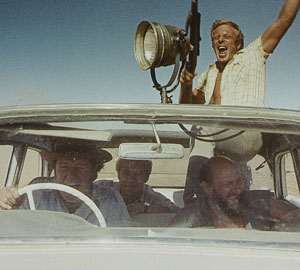Wake In Fright
June 29, 2009
Eye opener…Jack Thompson (top) in Wake In Fright.
REDISCOVERING Wake In Frightis less like running into an old friend than someone you feared as a child. There has never been a more savage and scabrous film about Australia. Unfortunately, it was also uncomfortably true, which was one reason Australians didn’t go to see it in large numbers when it came out in late 1971. It was just too confronting. Its power has hardly diminished in the years since, during which it became hard to see.
The film was hugely influential but mostly with nascent Australian filmmakers, some of whom saw it as a national disgrace that two great films had been made about Australia in one year, neither by an Australian (the other was Walkabout, directed by Nic Roeg). Perhaps that’s why they were so good they were made by people who didn’t have to live here.
Australia had no film industry to speak of in 1971. What there was gave us a rosier picture of ourselves the gentler comedy of They’re A Weird Mob, for example.
Wake In Fright took no prisoners. It was a vision of outback Australia as one of the inner circles of hell, a place of mad, murderous men and dull-eyed, sluttish women.
These were people who lived beyond the polite laws of civilisation, even if they tried to pretend otherwise. That was both repellent and attractive and that was the real paradox of the film it was all so ugly and yet so free. It was like an Australian version of John Milton’s Paradise Lost, asking similar questions: if men and women are able to live freely, what freedoms will they choose? In Wake In Fright, they chose every available sin, from drinking and gambling, to fornicating and killing.
The young schoolteacher John Grant (Gary Bond) arrives in the mining town of Bundanyabba (a thinly disguised Broken Hill) with a sense of superiority. He sniggers when the taxi driver tells him it’s the best place in Australia. He has just endured a dispiriting year at a one-room school in Tiboonda, a town that has only two buildings the other one being a pub. He’s expecting to get the plane back to Sydney for Christmas but human nature intervenes.
Local policeman Jock Crawford (Chips Rafferty, giving the best and last performance of his career) notices him in the corner of a pub that has about 300 thirsty customers, even after hours. Crawford is an odd mixture of menace and hospitality. After six or eight quick beers, Jock decides to show the young fellow around. They visit more packed pubs and the local RSL, where the only thing that interrupts the poker machines is the compulsory minute’s silence. Jock shows the hungry Grant into the cafe at the two-up school, where he meets the devil himself.
The references to heaven and hell are explicit in the film. The Yabba is a kind of Sodom, a despoliation of paradise, but most of the inhabitants don’t see it that way. When Grant sits down opposite Donald Pleasence in the cafe, Pleasence smiles and says: “All the little devils are proud of hell.”
So begins Grant’s undoing, the start of three debauched days during which he loses everything money, self-respect and self-delusions. Doc Tydon (Pleasence) becomes his companion and his undoing. Dick and Joe (Jack Thompson and Peter Whittle) take him ‘roo shooting in a sequence that is so brutal no one would film it today. Janette Hynes, the daughter of a local businessman (played by Sylvia Kay, the director’s wife), tries to uncover his manhood. In a sense, that’s what everyone does they’re all trying to find out if he’s a real man.
Kenneth Cook’s book was published in 1961. The rights were once owned by Joseph Losey, who wanted to make it with Dirk Bogarde. In the end it was a co-production – an Australian company associated with Bobby Limb and a US subsidiary of Westinghouse. The director, Ted Kotcheff, was Canadian, the screenwriter Jamaican. Evan Jones had worked with Kotcheff on the 1969 film Two Gentlemen Sharing. Many of the key production personnel were English but the editor was an Australian, Tony Buckley, who had worked with Michael Powell on Age Of Consent in 1969. Buckley later became a successful producer ( Caddie, Bliss, Bedevil) and he deserves most of the credit for this top restoration.
Buckley spent 10 years searching for the negative. He found it in a bin marked for destruction at the CBS vault at Iron Mountain, Pittsburgh. He collaborated with the National Film and Sound Archive and Atlab to restore the film to its original version. There was a slight difference between the Australian and international versions. The late Gary Bond was shown naked in two shots in the Australian release. He was wearing underpants in the other version but the restoration returns him to his natural state.
